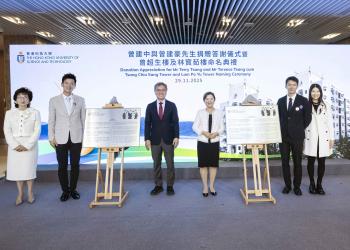What Is the Connection for President SHYY, Ingenuity and Leonardo Da Vinci?
The article is authored by CHEN Jay Chung, Professor emeritus of Department of Mechanical and Aerospace Engineering.
Recently, I had an opportunity to visit JPL (Jet Propulsion Laboratory) and listened to a talk by the scientists and engineers. They designed the cute little robotic helicopter, Ingenuity, which was brought to the Mars surface by the Perseverance rover spacecraft. Ingenuity successfully completed the first powered controlled extraterrestrial flight by a rotary-wing aircraft. My visit was a delightful reminiscence during the ever-glooming pandemic.
I had worked at JPL for 25 years before I joined HKUST in 1991 and retired in 2008 after 16 years. These are the only two places I ever worked permanently, a rather simple career for an academic person. During the presentation at JPL, it was pointed out that due to the Mars lower density atmosphere, the design of helicopter rotor airfoil is based on the low Reynolds number aerodynamics. The result is a very unusual airfoil shape for the helicopter rotor. One of the main design references was a publication by the Cambridge Press in 2007, Aerodynamics of Low Reynolds Number, authored by a person with an even more unusual Chinese last name, SHYY, the President of HKUST. I duly reported to our former President WOO Chia Wei who forwarded my report. Soon after, I received a brief note from President Wei SHYY requesting the relevant materials.
While sending a report describing in detail of the design process, I also mentioned another interesting and related research happened a few centuries before. Leonardo da Vinci (1452-1519) was an Italian polymath of the High Renaissance who is widely considered one of the most diversely talented individuals ever to have lived. He spent some forty years, his entire adult life, working on the problem of flight. His genius is apparent in his plan for a four-wing ornithopter, which very much resembles Mars helicopter, Ingenuity, as illustrated by the comparison images.

During my time at JPL, a series of planetary explorations were conducted. The Mars is the closest planet to the Earth and is a terrestrial planet with a solid surface. After several Mariner spacecrafts’ fly by the Mars and in 1976 two Viking spacecrafts with orbiter and lander confirmed the existence of Mars atmosphere albeit with a very low density.
Young scientists and engineers, then began to discuss dreamingly about landing a plane on Mars after a very long interplanetary journey arriving for the final phase of the trip to Mars.
One of the dreams:
“Mars Base, JPL001, landing site visual, request approach and land.”
“JPL001, Mars Base, signal clear, visual landing approach. Visibility 18, Temperature -20, wind 190 at 6, altimeter 10.05. clear to land.”
Almost half a century later, the dream was realized by the “the cute little robotic helicopter, Ingenuity” The answer to the question title of the present article is, of course, a non-dimensional mathematical number, i.e., “Reynolds number”.









